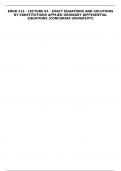lOMoARcPSD|2391136
ENGR 213 - LECTURE 03 - EXACT EQUATIONS AND SOLUTIONS
BY SUBSTITUTIONS APPLIED ORDINARY DIFFERENTIAL
EQUATIONS (CONCORDIA UNIVERSITY)
, lOMoARcPSD|2391136
2.4. Exact Differential Equations.
Differential of two variable functions. Given a two variable function z = f (x, y)
with a functional rule f (x, y). Then the expression:
∂f ∂f
dz = (x, y) dx (x, y) dy
+ ∂y
∂x
is called a differential of the function z = f(x, y). Here, ∂f (x, y) is the partial
∂x
derivative of f (x, y) with respect to x and ∂f (x, y) is the partial derivative of f (x, y)
∂y
with respect to y. In order to denote the differential of a two variable function given
with the differential rule f (x, y), the notation:
∂f ∂f
df (x, y) dx (x, y) dy
+ ∂y
= ∂x
is also acceptable.
Example. Consider the two variable function
2
f (x, y) = x3 + exy .
Then
2 2
df = (3x2 + y2exy )dx + 2yxexy dy
is the differential of the given function.
Remark. Obviously, d c = 0, where c is a constant function.
The functional equation
2
f (x, y) = c ⇒ x3 + exy = c,
where c is an arbitrary constant, represents a family of curves on the xy-plane. Com-
puting the differential from both sides of this equation generates a first-order DE
written in a differential form:
df = dc ⇒ df = 0
⇒ (3x2 + y2 xy )dx + xy 2
e
2
dy = 0 (1)
2yxe
dy
⇒ 2yxexy2 + 3x2 + y2 xy = 0 (2) 2
dx e
assuming that y is dependent variable
or, assuming that x is dependent variable
2 dx 2
(3x2 + y2exy ) + 2yxexy = 0 (3).
dy
1
, lOMoARcPSD|2391136
Going back from the DEs (1), (2), (3) to the given family of curves we conclude that
2
the one-parameter family of curves x3 + exy = c is an implicit solution of the DEs
(1), (2), (3).
Exact Differential Equation. Given a first-order differential equation in a differ-
ential form:
M (x, y) dx + N (x, y) dy = 0.
It is exact in a region R if there is a function f (x, y), defined on R, such that
df = ∂f ∂f
dx + dy = M (x, y) dx + N (x, y) dy.
∂x ∂y
Then, an implicit one-parameter family of solutions is:
f (x, y) = c, c arbitrary constant.
.
Criterion for Exact DE. Given a DE in a differential form:
M (x, y) dx + N (x, y) dy = 0,
where M (x, y) and N (x, y) are defined on a rectangular domain R { = (x, y) : a
< x < b, c < y < d }
in the xy-plane. Suppose that M (x, y) and N (x, y) have continuous
second order partial derivatives on R. Then the DE:
M (x, y) dx + N (x, y) dy = 0
is exact DE if and only if
∂M ∂N
= .
∂y ∂x
Necessity by using Clairaut’s Theorem
(see http : //en.wikipedia.org/wiki/Symmetry−of−second−derivatives).
Suppose that the DE
M (x, y) dx + N (x, y) dy = 0
2
, lOMoARcPSD|2391136
is exact. Then, there is a function f (x, y) such that
∂f ∂f
dx + dy = M dx + N dy
∂x ∂y
∂f ∂2f ∂M
⇒ =M⇒ =
∂x ∂x∂y ∂y
∂f ∂ 2f ∂N
⇒ =N ⇒ =
∂y ∂y∂x ∂x
and from here
∂M ∂N
= ,
∂y ∂x
taking into account that
2
∂ 2f = ∂ f ,
∂x∂y ∂y∂x
according to Clairaut’s Theorem
(see http : //en.wikipedia.org/wiki/Symmetry−of−second−derivatives).
The converse is also true under some restrictions on M (x, y) and N (x, y) and the
domain R:
If the DE satisfies the condition
∂M ∂N
= ,
∂y ∂x
then the DE is exact, i.e., a function f (x, y) exists such that
df = ∂f ∂f
(x, y) dx (x, y) dy = M (x, y) dx + N (x, y) dy
+ ∂y
or equivalently ∂x
∂f ∂f
(x, y) = M (x, (x, y) = N (x, y).
y); ∂y
∂x
Then, the one-parameter family of curves
f(x, y) = c, c arbitrary constant
is an implicit solution of the DE.
3




